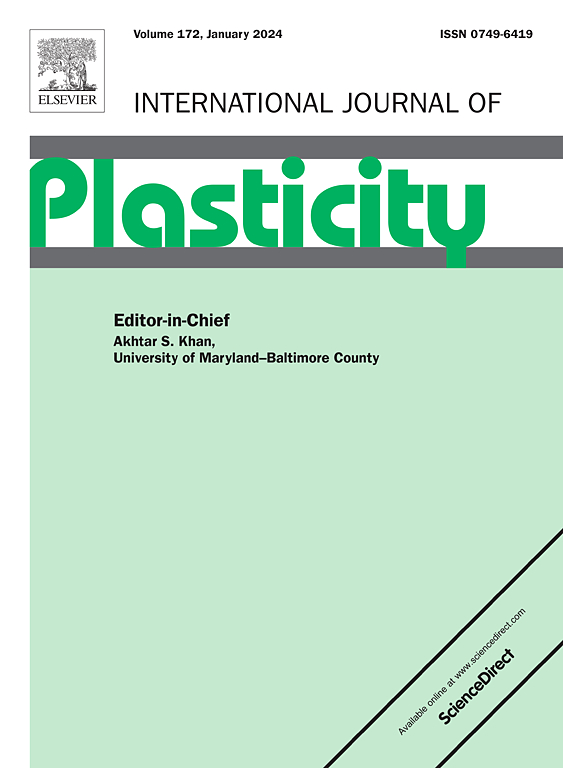激光冲击强化制备的稳定梯度纳米结构钛合金的微动耐磨性
IF 9.4
1区 材料科学
Q1 ENGINEERING, MECHANICAL
引用次数: 0
摘要
TC6钛合金广泛应用于航空发动机的叶片和紧固件结构中,微动磨损失效是常见的问题。为了应对这一挑战,人们采用了各种表面处理技术,其中激光冲击强化(LSP)因其出色的表面完整性而备受关注。虽然LSP已被广泛应用于改善钛合金的疲劳和摩擦性能,但对其对微动磨损性能的影响及其强化机制的研究还不够。在这项工作中,我们证明了在sps诱导的加工硬化层的促进下,稳定梯度纳米晶非晶亚结构的持续形成,导致钛合金在高载荷微动条件下的磨损率显著降低51.9%,从4.147 × 10-6 mm3 N-1 m-1降低到1.996 × 10-6 mm3 N-1 m-1。此外,通过多种显微技术和能量分析,系统研究了钛合金摩擦前后的梯度力学、表面形貌、能量耗散、显微组织演变和位错行为。钛合金优异的微动磨损性能源于表面硬化层、压缩残余应力和梯度纳米晶-非晶态亚结构的协同作用,这些亚结构抑制了微动滑移下基体的去除,并适应了大塑性应变。本研究为全面深入地了解lsp诱导的稳定梯度纳米结构的强化机制提供了新的思路,为钛合金表面微结构的定向设计优化提供了新的思路。本文章由计算机程序翻译,如有差异,请以英文原文为准。


Superior fretting wear resistance of titanium alloys from stable gradient nanostructures induced by laser shock peening
TC6 titanium alloy is widely utilized in the blades and fastener structures of aeroengines, where fretting wear failure is a common issue. To address this challenge, various surface treatment techniques have been employed, with laser shock peening (LSP) garnering significant attention due to its excellent surface integrity. Although LSP has been extensively applied to improve the fatigue and friction properties of titanium alloys, its impact on the fretting wear performance and relevant strengthening mechanisms remains insufficiently explored. In this work, we demonstrate that the continuous formation of stable gradient nanograin-amorphous substructures, facilitated by the LSP-induced work-hardening layer, results in a remarkable 51.9 % reduction in the wear rates of titanium alloys under high-load fretting conditions, decreasing from 4.147 × 10–6 mm3 N-1 m-1 to 1.996 × 10–6 mm3 N-1 m-1. Furthermore, through the application of multiple microscopic techniques and energy-based analyses, the gradient mechanics, surface morphology, energy dissipation, microstructural evolution, and dislocation behavior of titanium alloys pre- and post-friction tests are systematically investigated. The superior fretting wear resistance of titanium alloys stems from the synergistic effects of the surface hardening layer, compressive residual stress, and the evolution of gradient nanograin-amorphous substructures, which inhibit the matrix removal and accommodate large plastic strains under fretting slip. This work provides a comprehensive and in-depth understanding of the strengthening mechanisms of the LSP-induced stable gradient nanostructures, offering new insights into the targeted design optimization of surface microstructures for titanium alloys.
求助全文
通过发布文献求助,成功后即可免费获取论文全文。
去求助
来源期刊

International Journal of Plasticity
工程技术-材料科学:综合
CiteScore
15.30
自引率
26.50%
发文量
256
审稿时长
46 days
期刊介绍:
International Journal of Plasticity aims to present original research encompassing all facets of plastic deformation, damage, and fracture behavior in both isotropic and anisotropic solids. This includes exploring the thermodynamics of plasticity and fracture, continuum theory, and macroscopic as well as microscopic phenomena.
Topics of interest span the plastic behavior of single crystals and polycrystalline metals, ceramics, rocks, soils, composites, nanocrystalline and microelectronics materials, shape memory alloys, ferroelectric ceramics, thin films, and polymers. Additionally, the journal covers plasticity aspects of failure and fracture mechanics. Contributions involving significant experimental, numerical, or theoretical advancements that enhance the understanding of the plastic behavior of solids are particularly valued. Papers addressing the modeling of finite nonlinear elastic deformation, bearing similarities to the modeling of plastic deformation, are also welcomed.
 求助内容:
求助内容: 应助结果提醒方式:
应助结果提醒方式:


